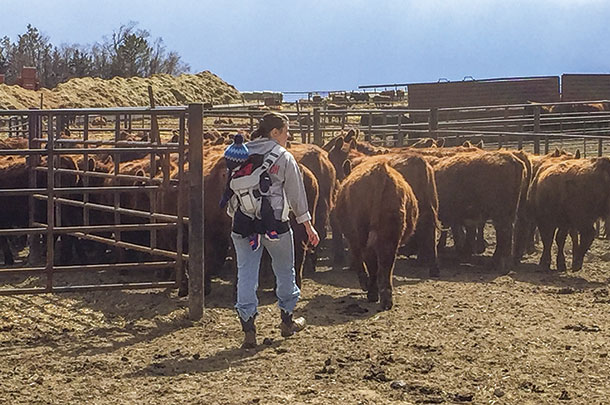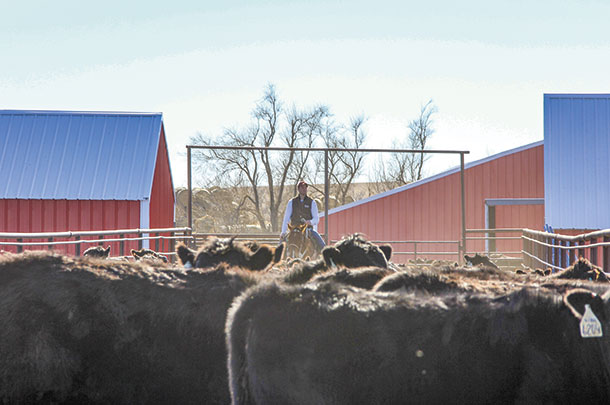Craig Howard, cow boss at Bieber Red Angus Ranch of Leola, South Dakota, says if you handle your cows right, their calves learn a lot by following mama’s example. They take their cues from her attitude and actions.
Jon and Breezy Millar raise registered Angus cattle at Millar Angus Ranch near Sturgis, South Dakota, and handle their cattle frequently. “We split our pairs as the calves are born,” says Jon. Cows with bull calves go to one pasture, and cows with heifer calves go to another.
“We spend a lot of time with them, checking the calves. We are often out there horseback or on foot,” he says.
For Joe Van Newkirk, whose family has raised Hereford seedstock near Oshkosh, Nebraska, for several generations, disposition is one of the criteria he uses in selecting replacement heifers, and he says it’s becoming even more important today.
“Most of the people raising cattle are getting older and want cattle that are easy to handle,” he says. One advantage with Herefords is: On average, they tend to have an easygoing temperament.
Easy-handling cattle are made that way by a combination of genetics and how they are handled. Even cattle that inherit a mellow disposition can be made spooky, wild and dangerous with the wrong kind of handling. Low stress from the time they are calves is the best way to end up with user-friendly cattle.
“As we move calves around, we try to keep everything low-key,” says Howard. “I see a lot of ranches where people don’t know when to take the pressure off, whether with young calves or during weaning/preconditioning or later.” The animals don’t get any reward/relief from taking the pressure off, so they never learn how to do the right thing when being moved or sorted.

“Coming into the alleys approaching the chute, a lot of people are quiet – but then, when they get the cattle right up to the alley, they want to holler and beat on them. It’s better to put pressure on them in the back as you approach and then ease up when they are going the right direction. If they are trying, they should get rewarded for trying,” he explains.
“It might take a few minutes to pause and let that cow or heifer think about it for a moment but, in the end, everyone is much better off.” The cow can then figure out where it should go, not just reacting automatically with a fight or flight response.
Young calves
Calves become familiar with people when their mothers are handled and, if done in a low-stress manner with non-spooked cows, the calves are not afraid of humans. By contrast, if calves are born out on the range and never see a human until round-up time (and cows are semi-wild), the calves are scared and flighty.
Van Newkirk’s calves get weighed, vaccinated and tagged at birth. “We try to get hold of them and accomplish these tasks as low-stress as we can,” says Van Newkirk. If mama is cooperative, not sending out bad vibes to her baby, the calf is not afraid and realizes the human is not a predator.
Take advantage of weaning
On the Bieber ranch, when the calves are weaned, they are monitored closely to make sure they stay healthy. “Someone goes through them at least once a day, and that helps gentle them,” says Howard. “We feed a little supplement after they are back out on grass. They don’t come up to the bunks at first, so we go out there and gather them up. They get used to being picked up and pushed around. This makes it easier to handle them later,” he says.
Van Newkirk says weaning is when you need to handle them quietly and interact with them a lot. “This is when you can really make a difference. We sort them with no stress; they go through the alley, and we have a hydraulic gate in front of the chute and sort the calves as they go through. We put heifers on one side and males on the other,” says Van Newkirk.
“A few years ago, we started to hand-feed the heifers in their weaning pen and walk through them a lot. The first couple days, they are still a little upset without their mothers. My son Kolby, our hired man Travis Kezar and I (and whoever else we can get) walk through those heifers several times a day. In a few days, the heifers are totally used to it. You have to actually walk through them; you can’t just drive or ride through them. They need to see you out there on foot,” Van Newkirk says.
“They are gentle from then on if you keep handling them with low stress, and that translates into gentle cows that pass a quiet attitude on to their calves. We do this every year, and it all compounds to make quiet cattle,” he explains.
The Millars implemented a pasture weaning system about five years ago. “It’s low-stress, and the calves stay quiet. We just pull the cows out and put them in a pasture next to the calf pasture. The heifers have their mothers right through the fence, so they don’t get all riled up. This is much easier on them than putting the calves in a corral and taking their mothers far away,” says Millar.

“When we feed them during winter, we walk through them each day after we feed, so they associate us with something good. They are eager to see us,” Millar says.
Low-stress working
A couple weeks after the Van Newkirk calves are weaned, they are re-vaccinated. “Everything is slow and quiet. We have a double alley to our squeeze chute, all under a roof. The double alley makes it less stressful because the calves are next to each other until they get right to the chute, and then they funnel into single-file,” says Van Newkirk.
The cattle are familiar with the corrals and are not afraid to come in. “They’ve never been hurt there, and they are handled quietly as they come in.” How they are handled makes a big difference in their future attitude. ![]()
PHOTO 1: Bieber calves in portable corral being sorted for weaning.
PHOTO 2: Craig Howard’s wife and infant son moving heifers. Photos courtesy of Bieber Red Angus Ranch.
PHOTO 3: Jon Millar riding through a group of weaned heifers. Photo courtesy of Jon Millar.
Heather Thomas is a freelance writer based in Idaho.






